Why does steel require fire protection?
Answer:
Critical failure of steel occurs when the steel reaches 1,000°F (537°C). At this point, unprotected steel is reduced to 60% of its original strength, is prone to bend and deflect and the structural load stability and physical characteristics of steel is compromised.
What is an Intumescent Coating?
Answer:
Intumescent Fire Resistance Coatings are paint-like coatings that expand and char in a fire to insulate structural steel for up to 4-hours.
Thin Film Intumescent Coatings give Architects the ability to design using structural steel that can be decorative and aesthetically pleasing. Intumescent Coatings can be top coated to match their surroundings and allow steel to be left exposed to view while providing the necessary fire resistance ratings.
What is the Rating per inch of Fireproofing?
Answer:
Fireproofing, like all fire resistive products, does not have a rating by itself. Ratings are assigned to complete assemblies such as floors, roofs or walls which must be constructed in strict accordance with published test results in order to achieve the rating indicated. The use of fireproofing in conjunction with other components makes it possible to achieve ratings of up to 4 hrs.
What is the typical Rating required for Fireproofing?
Answer:
Ratings are based on Building Code requirements and are determined based on the size of the building, its height, the number of stories, its use and whether it is sprinklered or not.
How much does Fireproofing cost?
Fireproofing costs are based on many factors including the type of fireproofing used, what it is protecting and the ratings required.
Why are there different types of Fireproofing?
Answer:
Some fireproofing products are intended for tempered interior use whereas others can be used in untempered conditions and still others may be used for exterior use. Most fireproofing products are intended to be concealed from view in its end use, while others are intentional left exposed to view for dramatic effect. Of course, costs will vary among products and uses.
How long will Fireproofing last?
Answer:
When properly installed and maintained, fireproofing will last for the life of the building.
What is fire resistance?
Answer:
The fire resistance of a steel component is its ability to withstand fire for a period of time under conditions of heat intensity.
What is a Passive Fire Protection Material?
Answer:
Passive fire protection materials are designed to safeguard the structural integrity of steel under fire conditions and to maintain safe temperatures for a specified period of time.
Who Determines the Fire Resistance Rating?
Answer:
What is a Spray-Applied Fire Resistive Material (SFRM)?
Answer:
In the past, industry defined product classifications as “Cementitious Mixtures” or “Sprayed Fiber” materials. These product classifications have been withdrawn and combined to form a new single product classification called Spray-Applied Fire Resistive Material (SFRM).
The term “cementitious” often misleads design professionals to believe that the product contains cement, when in fact, most commercial density fireproofing products called “cementitious” do not. Ironically, most of the materials that were included in the “Sprayed Fiber” category actually do contain cement.
The industry has categorized SFRMs as either “Wet Spray” or “Dry Spray” materials. These terms better describe the manner in which the material is mixed, conveyed and applied.
How long does it take for the material to dry?
Answer:
Depending upon thicknesses, environment conditions (i.e. temperature, air-flow, moisture, etc.), the period required for Spray-Applied Fire Resistive Materials (SFRMs) to fully cure is 14 to 28 days or more.
This assumes that ventilation is properly provided, particularly when spraying in enclosed areas such as basements, stairwells, shafts, and small rooms. A minimum of 4 complete air exchanges per hour is required until the material is dry.

